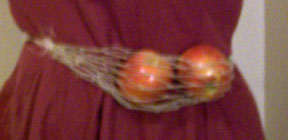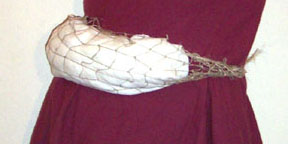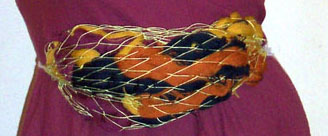

Main Menu - Misc. - Clothing/Textiles - Medieval Wales - Names - Other Medieval - Publications - Harpy Publications
Return to main page


The net-only bags of the Tres Belles Heures (the only completely unambiguous example of a net with no lining) show the meshes set square to the waistline. There are two possibilities: a tubular bag with the ends gathered, one of which can be opened to access contents; or a more "hammock" like object -- a flat rectangular net gathered at opposite ends with access through an open side. For these and the following experiments I made a piece of netting with roughly one-inch meshes, approximately 18" x 36". To approximate the apparent dimensions of the Tres Belles Heures bag I folded this piece in half to form a square.

For the "hammock" style, I threaded a cord through the meshes at each end in a double loop to gather it, then tied the ends of each around a belt. The result is capable of holding several relatively bulky objects and looks roughly like the illustration. It's a little unstable, and if it's simply tied to a belt (rather than being fastened to specific points) has a tendency to sag.
For the "tube" style, I started with the same square (i.e., folded rectangle), but used a cord to "sew" opposite edges together. As above, I threaded a cord through the meshes at each open end (but only in a single loop this time, since I wanted to be able to loosen and open one end) and used the loose ends to fasten the bag to a belt. The results were similar to that described for the corresponding tubular "crescent" style below. Overall, the open "hammock" style seems the best combination of matching the picture and practicality of use.
The "netted crescent" style calls for a longer net. For these experiments, for the "square" mesh, I used the above 18x36" rectangle in its full size (optionally sewn into a tube for the second experiment). For the "lozenge" style, I made two nets: one flat, roughly 12x24", and one tubular roughly 12" long and 24" in circumference. As for the above experiments, I tried two styles: a tube and a "hammock" style (although this name is less appropriate since the net doesn't hang loosely). In each case, each end is gathered on a cord and the cords are tied together around the waist to fasten the pouch. The square-mesh models were created as seen above, only longer. The lozenge-mesh models were roughly as seen below.

The "hammock" style square-mesh net is unstable, and the contents (in this case, folded in a cloth) are prone to falling out fairly easily. (Not illustrated.) Furthermore, the natural properties of the net when the meshes are oriented squarely tend to make the resuling shape more of a blunt sausage, and not the tapering shape seen in the pictures. However this problem is even worse if the same attempt is made with a hammock-style "lozenge" mesh net. (See below.) The edges have no stability and any contents are soon dumped out.

Using the tubular style, the tapered shape tends to emerge in both styles (square and lozenge style meshes), although more clearly with the lozenge-shaped meshes. In both cases, the closed bag keeps the contents very secure. Ease of access is significantly different, however. The square-mesh bag can't expand around its circumference, so you find yourself threading the contents into a long, narrow, essentially non-elastic tube. This is difficult. In contrast, the lozenge-shaped mesh bag expands easily due to its structure. (See below.)




Overall, the crescent-shaped net works best using a lozenge-mesh tube with gathered ends. The square-mesh tube is less practical for adding and removing contents, while the open ("hammock" style) arrangement doesn't securely hold the contents.
Previous --------------------------------------------- Main --------------------------------------------- Next
This site belongs to Heather Rose Jones. Contact me regarding anything beyond personal, individual use of this material.
Unless otherwise noted, all contents are copyright by Heather Rose Jones, all rights reserved.